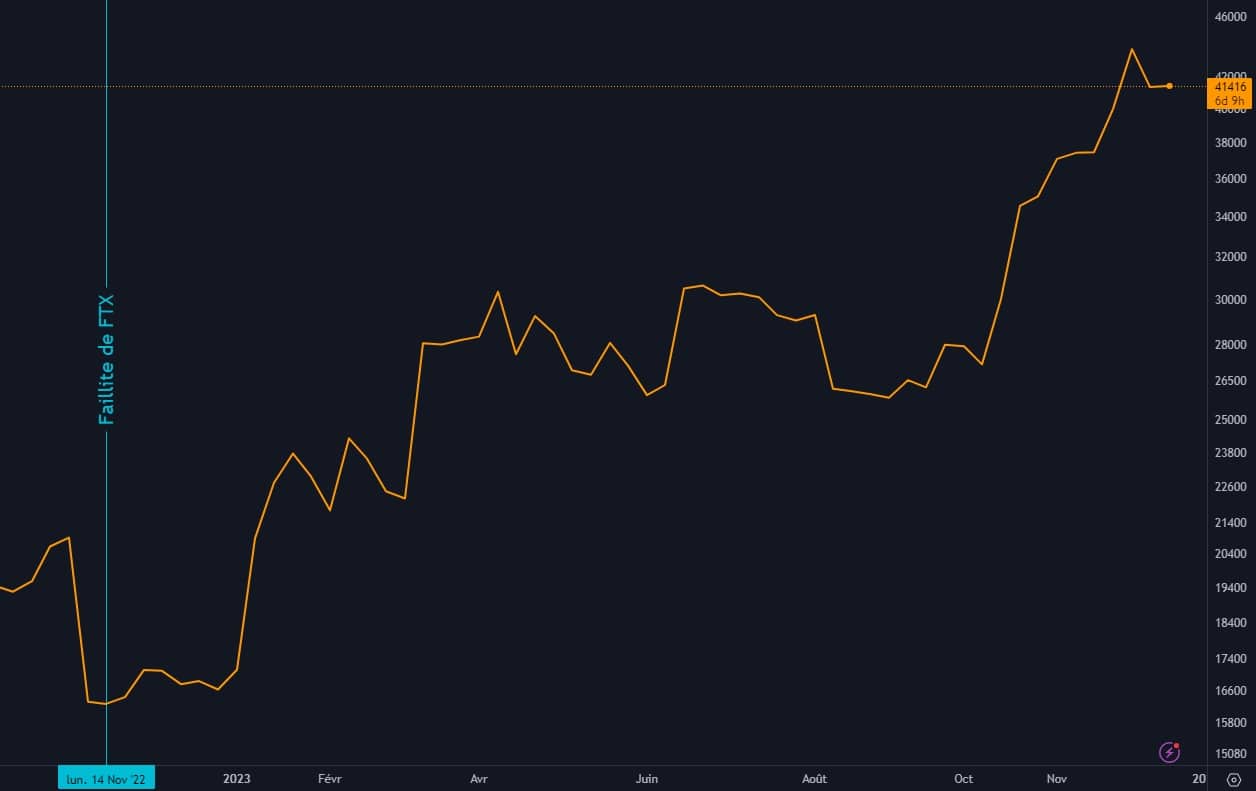Cryptocurrency exchange FTX, facing bankruptcy since November 11, 2022, has announced a repayment plan that has prompted mixed reactions among its former customers. The plan, based on the value of funds at the time of bankruptcy, which might appear reassuring on the surface, could ultimately represent a considerable financial loss for many users.
FTX unveils reorganization plan
Cryptocurrency exchange FTX, declared bankrupt on November 11, 2022, has announced in its reorganization plan the intention to refund funds lost by its customers based on their value at the time of bankruptcy.
This announcement may seem reassuring for some former users of the platform, but for many, it represents a significant financial loss.
Indeed, at the time of FTX’s collapse, the market was at its lowest point in 2 years. Since then, the cryptocurrency market has recovered by almost 85%, while the Bitcoin price has risen by over 140%.

Bitcoin’s price evolution since the FTX bankruptcy
Sunil Kavuri, an activist creditor at FTX who lost around $2 million as a result of the company’s bankruptcy, criticized the repayment plan in a post on Network X.
He argues that FTX’s proposed repayment plan violates the platform’s terms of service, which normally guarantee customers ownership of their digital assets, not the company.
FTX Debtors have filed the reorg. Plan
Most importantly they have ignored FTX TOS that states Digital Assets are the property of Users and not FTX Trading
The plan says that Digital Assets are valued at Petition Date conversion rates (prices) pic.twitter.com/WTj07nlOP5
– Sunil (FTX Creditor Champion) (@sunil_trades) December 16, 2023
FTX’s reorganization plan is designed to refund customers fairly, while avoiding lengthy legal proceedings, such as those seen in the Mt. Gox case that has dragged on since 2014.
However, this plan is subject to a vote for which only certain creditors have a voice to contribute, so it could be imposed on some creditors who won’t have a say. While the decision may disadvantage some parties affected by the bankruptcy, it is intended to ensure an efficient resolution of the case, according to the FTX filing.
The main groups of creditors and customers involved in the bankruptcy proceedings have already approved the plan. It will be put to a vote by other creditors later next year, before being presented for final evaluation by U.S. Bankruptcy Judge John Dorsey, who will have to deem the plan “fair and equitable” to be generally enforced.
FTX is drowning in debt
This situation is all the more frustrating when you consider that FTX is disbursing around $1.3 million a day in bankruptcy fees, paid to various firms such as Sullivan and Cromwell, or Alvarez and Marshall.
Total legal fees paid out by FTX since its bankruptcy thus reach around $1.45 billion, more than the $1.42 billion owed to its customers.
Latest numbers from the FTX bankruptcy are interesting:
Customer shortfall: $1.422 Billion
Bankruptcy fees: $1.45 Billion pic.twitter.com/FhCtFPeQ3z– Jameson Lopp (@lopp) December 17, 2023
This disproportion between the debts raises concerns about the usefulness of making such expenditures, especially considering that they could have contributed to reimbursing some of the victims of the bankruptcy.
As a reminder, the U.S. Internal Revenue Service had demanded $44 billion in taxes from the company by April 2023. Seeing that the company was having difficulty paying such a sum, the claim was revised twice and lowered to $24 billion.
